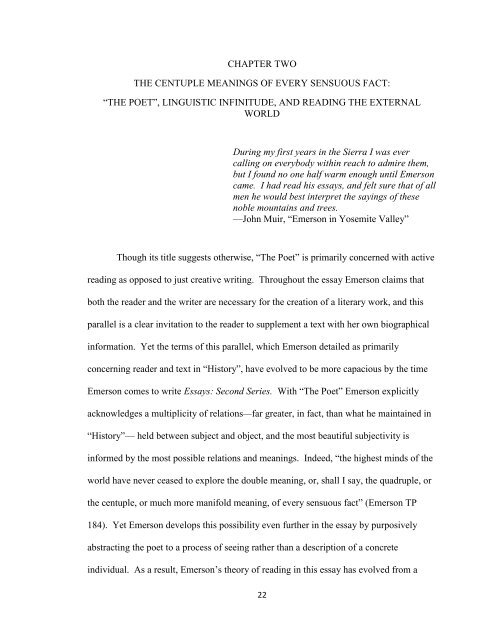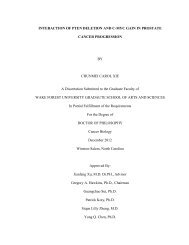RALPH WALDO EMERSON AND THE EVER-EVOLVING ART OF ...
RALPH WALDO EMERSON AND THE EVER-EVOLVING ART OF ...
RALPH WALDO EMERSON AND THE EVER-EVOLVING ART OF ...
Create successful ePaper yourself
Turn your PDF publications into a flip-book with our unique Google optimized e-Paper software.
CHAPTER TWO<br />
<strong>THE</strong> CENTUPLE MEANINGS <strong>OF</strong> <strong>EVER</strong>Y SENSUOUS FACT:<br />
“<strong>THE</strong> POET”, LINGUISTIC INFINITUDE, <strong>AND</strong> READING <strong>THE</strong> EXTERNAL<br />
WORLD<br />
During my first years in the Sierra I was ever<br />
calling on everybody within reach to admire them,<br />
but I found no one half warm enough until Emerson<br />
came. I had read his essays, and felt sure that of all<br />
men he would best interpret the sayings of these<br />
noble mountains and trees.<br />
—John Muir, “Emerson in Yosemite Valley”<br />
Though its title suggests otherwise, “The Poet” is primarily concerned with active<br />
reading as opposed to just creative writing. Throughout the essay Emerson claims that<br />
both the reader and the writer are necessary for the creation of a literary work, and this<br />
parallel is a clear invitation to the reader to supplement a text with her own biographical<br />
information. Yet the terms of this parallel, which Emerson detailed as primarily<br />
concerning reader and text in “History”, have evolved to be more capacious by the time<br />
Emerson comes to write Essays: Second Series. With “The Poet” Emerson explicitly<br />
acknowledges a multiplicity of relations—far greater, in fact, than what he maintained in<br />
“History”— held between subject and object, and the most beautiful subjectivity is<br />
informed by the most possible relations and meanings. Indeed, “the highest minds of the<br />
world have never ceased to explore the double meaning, or, shall I say, the quadruple, or<br />
the centuple, or much more manifold meaning, of every sensuous fact” (Emerson TP<br />
184). Yet Emerson develops this possibility even further in the essay by purposively<br />
abstracting the poet to a process of seeing rather than a description of a concrete<br />
individual. As a result, Emerson’s theory of reading in this essay has evolved from a<br />
22




